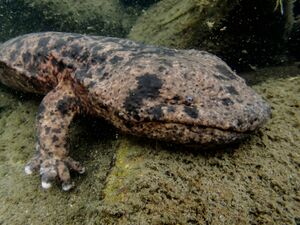Japanese giant salamander: Difference between revisions
No edit summary |
|||
| Line 1: | Line 1: | ||
The '''Japanese giant salamander''' (''Andrias japonicus'') is one of the five species of salamander found to be a member of the family Cryptobranchidae. This family is defined by it consisting of the largest living amphibians, along with all members being fully aquatic [[salamanders]]. With a length of up to 5 feet<ref name = amphibiaweb>[http://amphibiaweb.org/cgi-bin/amphib_query?query_src=aw_lists_genera_&table=amphib&where-genus=Andrias&where-species=japonicus ''Andrias japonicus''] Retrieved 05/09/2022- Amphibiaweb</ref>, the Japanese | The '''Japanese giant salamander''' (''Andrias japonicus'') is one of the five species of salamander found to be a member of the family Cryptobranchidae. This family is defined by it consisting of the largest living amphibians, along with all members being fully aquatic [[salamanders]]. With a length of up to 5 feet<ref name = amphibiaweb>[http://amphibiaweb.org/cgi-bin/amphib_query?query_src=aw_lists_genera_&table=amphib&where-genus=Andrias&where-species=japonicus ''Andrias japonicus''] Retrieved 05/09/2022- Amphibiaweb</ref>, the [[Japanese giant salamander]] is the third largest species of [[salamander]] living. They are highly endemic being found in southwestern Japan (west of Gifu Prefecture in Honshu and parts of Shikoku and Kyushu) in fast flowing mountain streams. | ||
Revision as of 21:12, 10 May 2022
The Japanese giant salamander (Andrias japonicus) is one of the five species of salamander found to be a member of the family Cryptobranchidae. This family is defined by it consisting of the largest living amphibians, along with all members being fully aquatic salamanders. With a length of up to 5 feet[1], the Japanese giant salamander is the third largest species of salamander living. They are highly endemic being found in southwestern Japan (west of Gifu Prefecture in Honshu and parts of Shikoku and Kyushu) in fast flowing mountain streams.

| |
| Kingdom: | Animalia |
|---|---|
| Phylum: | Chordata |
| Class: | Amphibia |
| Order: | Urodela |
| Family: | Cryptobranchidae |
| Genus: | Andrias |
| Species: | A. japonicus |
| Source: Integrated Taxonomic Information System[2] | |
Description
Diet
With the Japanese giant salamander living its entire life in the water the diet consists of freshwater fish, frogs, and crabs. Due to the slow metabolism of the salamander the species can go without eating for days.[3] With the species large size it has no natural predators.
Behavior
Conservation
Threats
Due to the species being highly endemic, the biggest threat to the Japanese giant salamander is habitat loss. This is due to human activity damming up riverbeds and freshwater sources occupied by the giant salamander. Climate change is also a source for concern to the Japanese giant salamander due to estimated rainfall increasing leading to the destruction of streambeds.[4] This introduction of the Chinese giant salamander has lead to hybridization between the two species, posing a big threat to the native species. Studies done from 2011 to 2013 showed that 95% of all Japanese giant salamanders captured were hybrids, and were captured in multiple locations.[3]
Efforts
The "Japanese giant salamander"
References
- ↑ Andrias japonicus Retrieved 05/09/2022- Amphibiaweb
- ↑ "Integrated Taxonomic Information System - Report", ITIS USGS Open-File Report 2006-1195: Nomenclature", USGS, n.d.. Retrieved 5/9/2022.
- ↑ 3.0 3.1 “Discover How Scientists Have Recreated the Benefits of Insects' Compound Eyes as Compound Lenses.” Encyclopædia Britannica, Encyclopædia Britannica, Inc., https://www.britannica.com/video/216533/Artificial-bug-eyes-could-lead-to-new-vision-systems. Retrieved 5/9/2022
- ↑ Ministry of the Environment, Ministry of Education, Culture, Sports, Science and Technology, Ministry of Agriculture, Forestry and Fisheries, Ministry of Land, Infrastructure, Transport and Tourism, & Japan Meteorological Agency (2018): Climate change in Japan and its impacts. – Synthesis Report on Observations, Projections and Impact Assessments of Climate Change, 2018 Retrieved 05/9/2022